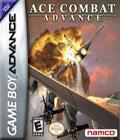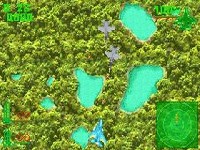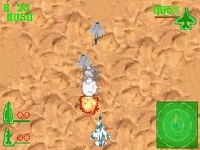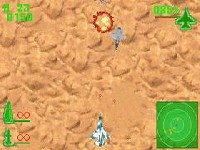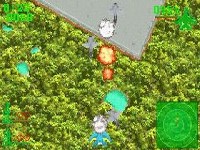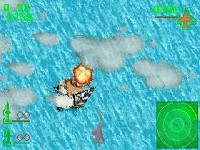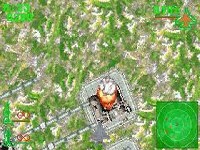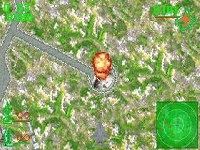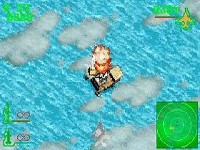Genre: Flight
Publisher: Namco
Developer: Human Soft
Release Date: February 23, 2005
Its movie-like atmosphere, graphics, sounds, and the "Top Gun" factor all have helped drive the Ace Combat series to become a favorite amongst thrill-seeking gamers. It must have seemed like a natural step to take the series to the Game Boy Advance, and while it's great to see Namco supporting the GBA in the twilight of the popular handheld's life, Ace Combat Advance should have – and could have – been so much more.
The story is one of those well-told tales about the future, where rich companies have taken over the globe and can afford to build their own armies and air forces. The particular enemy in Ace Combat Advance happens to be General Resources, Ltd., no doubt a purveyor of cheap manufactured goods and proponents of slave labor. With their superior monetary might and their Air Strike Force (ASF), they set out to eliminate anyone who attempts to thwart their goal of lower wages and higher profits.
Of course, this doesn't sit well with the international community, so a new military force is formed, and the player takes the role of a pilot in the United Air Defense (UAD) that has been assigned the task of destroying the menace known as General Resources.
The hackneyed storyline is just one of the many flaws which hamper the enjoyment of Ace Combat Advance. The game takes place over 12 missions, which have the player piloting one of a possible 10 planes. The planes have to be unlocked by completing the primary and secondary mission goals, which are set out at the beginning of each mission in the briefing room. At the end of the mission, the player is given a ranking, with a rank of "S" being the best. One of the most unforgiving aspects of this game is the fact that there is no save system. Instead, the game relies on an antiquated password system, which forces the player to write down a sequence of letters and numbers after each mission if they don't feel like finishing the game in one sitting or leaving their GBA on. This does little to enhance the "pick up and play" value of the game, because few people really feel like jotting down passwords which are easily lost or misplaced, especially when playing a handheld title.
The missions consist of the "seek and destroy" variety, with the player told to follow waypoints and destroy targets along the way. The game is played from a top-down perspective, which is a definite departure from the "in-cockpit" view that is normally associated with Ace Combat. That's not to say that it isn't a good choice for the GBA; it actually works quite well. The game is given a "free-roaming" feel by allowing the player to turn left and right to circle back around to targets or flee from enemies, and the terrain below rotates with the player's movement, which is a pretty neat effect. Another unique aspect to Ace Combat Advance which sets it apart from a typical top-down shooter is the fact that the plane can descend to ground level in order to avoid missiles and enemy fighters. When the player descends, the ground and other objects scale appropriately, growing larger or smaller relative to the plane's altitude.
While the graphical scaling and rotating effects serve this title well and look nice, the overall graphical feel of this game is fairly bland. Each plane has a distinctive look, but the fact that all the enemy planes are red and the friendly planes are blue obscures the details. Ground targets often don't look anything like the missile launchers or other targets they are supposed to represent, and the terrain below is extremely monotonous, featuring green trees, white snow, brown mud, and blue sea in an endlessly repeating, homogenized landscape. Thankfully, the player isn't forced to remember where the targets are or how to find them; a radar screen is provided, which highlights ground targets, air targets, and also features little arrows which represent the general direction of the primary and secondary objectives. The best looking parts of the game are the screens which are displayed upon successful completion of a mission or when the player meets an untimely demise. They serve as replacements for the excellent cut scenes found in the console versions of the series; unfortunately they are static and boring.
The sound of the game is standard air combat fare. There are some basic musical riffs in the menus and cut scenes, but the during the game, there are only a series of drumbeats with an underlying bass line which is almost impossible to hear.. There are engine noises, the rat-a-tat of machine guns, and the launching of missiles, all sounding like something which could've been reproduced on the NES. The player will often hear the annoying beep of an incoming missile and the simple crash of explosions. The sound is basic at best and adds nothing to the Ace Combat Advance experience.
The game controls easily enough, with the up arrow serving as the "dive" button, the right trigger handling the afterburner, and the A and B buttons serving as machine gun and secondary weapon. One of the first things that will irk players of the game is how slowly the planes fly. These are supposed to be top of the line jet fighters, screaming along at a speed which will break the sound barrier and cause windows to shatter below. Instead they move at a snail's pace, and more often than not the player will spend time waiting for the afterburner gauge to recharge so they can get moving. Even the planes with a faster speed rating still seem to inch along.
Once engaged in combat, the game begins to pick up a bit. It's quite fun to strafe enemy missile sites and dogfight with the ASF fighters. When the plane takes damage, it's represented by a percentage and a tiny outline of the plane in the corner of the screen. Once 100% damage is reached, the plane is destroyed and the game is over. In the lower left-hand corner is a graphical representation of the secondary weapon along with a number representing how many shots are left of that particular ordnance. Of course, when the plane gets too damaged or the secondary weapon is completely discharged, victory is not lost. At any time – and this means whenever and however many times the player wants – the select button can be pressed and a tanker appears which will both repair plane damage and replenish the weapon bays. This really makes the game beyond easy, and there's no incentive to avoid using this technique.
There is a time limit to complete each mission, putting pressure on the player to get things done as quickly as possible. This really discourages exploration and shortens the title considerably. Since the player is given a free pass to reload and repair at any time, it's hard to die. The only reason to replay the game would be to get the S ranking on each level, but there's little incentive, since the only reward is a new plane which moves as slowly as the last. There's no multiplayer mode, not that it would've made the game more enjoyable. There are no additional gameplay options or modes which open up with a successful completion. It's just 12 extremely short missions, each quite similar to the last.
If the developers had focused on making this title more of a 2D shooter on rails instead of trying to recreate the Ace Combat experience on the GBA screen, it could have been more enjoyable. Something with one plane, pitted against hordes of oncoming enemies, with power-ups and high scores would've been a good choice. As it stands, Ace Combat Advance should be relegated to the shelf as a sad departure from the rest of the titles in the Ace Combat series.
Score: 5.0/10
More articles about Ace Combat Advance










